Occupational Environment Monitoring at the Treadmill Manufacturing Factory
99,000 ₫
Note: The above price is calculated for one sample, and the price may fluctuate depending on the area of the environment to be monitored and market movements. For more accurate pricing support, please refer to the pricing table or contact our consulting staff directly.
Environmental monitoring of a chemical factory is a session of collecting, analyzing, and evaluating workplace factors that may be harmful to workers’ health.
Table of Contents
Toggle1. Overview of Treadmill Manufacturing Factories
a. What is a treadmill manufacturing factory?
A manufacturing factory for treadmills is a production facility specializing in the production and assembly of various types of treadmills. Treadmills are widely used in gyms, fitness clubs, and by individual users at home for exercise and maintaining health.

b. Production stages in treadmill manufacturing factories
In a treadmill manufacturing factory, the production stages include:
- Design and research: Engineers and designers undertake the research and development of new treadmill models. They create technical designs, drawings, and simulations to ensure the functionality and performance of the treadmill.
- Component production: Parts such as the frame, pedals, control units, and electronics are produced in-house or ordered from other suppliers. This stage includes metalworking, plastic fabrication, and other production processes to create the necessary components.
- Assembly: Components are assembled into a complete treadmill. Workers assemble parts like the frame, pedals, running belt, control unit, display, etc., and connect these parts with the treadmill’s electrical and electronic systems.
- Testing and quality control: Each treadmill is tested and quality-checked before packaging and shipping. Testing includes frame inspection, functionality checks, durability tests, and safety checks.
- Packaging and shipping: After testing and quality control, treadmills are packaged and prepared for shipment to distributors or end customers.

c. Types of machinery used in treadmill manufacturing factories
In treadmill manufacturing factories, several types of machinery and equipment are used to carry out the production process. Some commonly used machinery includes:
- Metal cutting machines: Used to cut and shape metal parts such as running frames, pedals, and other treadmill components.
- CNC machining machines: Used for precision machining of metal parts according to specific designs. CNC machines can perform milling, turning, drilling, and other operations with high accuracy.
- Plastic injection machines: Used to produce plastic parts of the treadmill, such as pedals or other components. Plastic injection machines use heat and pressure to create parts with precise shapes and dimensions.
- Welding machines: Used to weld metal parts together. Various welding methods such as electric welding, MIG/MAG welding, TIG welding, or laser welding can be applied depending on the product’s technical requirements.
- Plastic molding machines: Used for producing complex or large plastic parts. These machines use molding and injection techniques to create parts with detailed shapes.
- Quality inspection machines: Includes machines for checking and ensuring that treadmills meet quality and performance standards. These may include durability testers, vibration testers, electronic measurement devices, and other inspection tools.
- Assembly machines: Used to assemble different treadmill components into a complete product. Assembly machines are often specially designed to enhance efficiency and ensure accuracy during assembly.

d. Occupational diseases treadmill factory workers may face
Workers in treadmill manufacturing factories may be at risk of certain occupational diseases related to their work and environment. Some common occupational health issues include:
- Musculoskeletal disorders: Continuous work in unnatural postures and repetitive movements can cause musculoskeletal issues such as muscle inflammation, back pain, spinal disc degeneration, and carpal tunnel syndrome.
- Joint disorders: Repetitive actions during assembly or quality testing can lead to joint inflammation, degeneration, and other joint problems.
- Nervous system disorders: Exposure to noise from machinery and equipment during treadmill production can cause nervous system damage, including strokes, tinnitus, and hearing loss.
- Respiratory diseases: Exposure to dust and fumes during production may cause respiratory issues such as pneumonia, asthma, and respiratory allergies.
- Skin diseases: Contact with chemicals, grease, and other agents in the production process can cause skin problems such as dermatitis, allergic reactions, and infections.
- Eye diseases: Working in strong light conditions or exposure to ultraviolet rays from machinery may cause eye problems like conjunctivitis, myopia, and retinal damage.
To ensure the safety and health of workers, appropriate occupational safety and protection measures should be implemented in treadmill manufacturing factories.

e. Common treadmill types on the market
There are many common types of treadmills available on the market with various features and functions. Some popular treadmill types include:
- Electronic treadmills: The most common type used in gyms or households. They feature an electronic belt and display to track distance, speed, time, heart rate, and other parameters.
- Foldable treadmills: These treadmills can be folded when not in use to save space. Ideal for small apartments or limited spaces.
- Professional treadmills: High-end treadmills used in professional gyms or medical facilities, capable of high-speed running and multifunctional, with smart measurement features.
- Non-electric treadmills: Mechanical treadmills that do not require electricity. Users run using their own body power on the belt.
- Outdoor treadmills: Designed for outdoor use, with durable frames resistant to harsh weather and water-resistant features.
- Smart treadmills: Integrates smart technology, connects to mobile apps or monitoring systems to track workouts, provide personalized training programs, and offer entertainment features like movies, music, and social media access.
2. Overview of Occupational Environment Monitoring Services
a. What is occupational environment monitoring at treadmill manufacturing factories?
Occupational environment monitoring (or workplace environment measurement) at treadmill manufacturing factories involves collecting, assessing, and analyzing measurements of occupational environment factors to implement timely measures, minimize environmental hazards to workers’ health, and prevent occupational diseases. Occupational environment monitoring is mandatory for treadmill manufacturing factories.
Occupational environment monitoring plays a crucial role in protecting and promoting workers’ health, as employees are the main resource of a company and directly generate its profit. Workers frequently exposed to hazardous factors beyond allowable limits may suffer health impacts and develop occupational diseases.
REGISTER FOR OCCUPATIONAL ENVIRONMENT MONITORING SERVICE
b. Nam Viet’s occupational environment monitoring program
Nam Viet’s occupational environment monitoring program is developed by engineers specializing in occupational safety and environmental protection. To ensure workers’ health and safety, this program uses modern measurement methods to monitor air quality, water, microclimate factors, physical conditions, dust, and more in the workplace. It is an essential program for maintaining a safe working environment and protecting workers’ health.
Additionally, Nam Viet’s program contributes to research and development of solutions to improve workplace environmental quality. With the dedication and professionalism of its monitoring experts, Nam Viet’s exclusive monitoring program has become a breakthrough in labor safety management and environmental protection in Vietnam.

c. Standardization in workplace measurement procedures
Standardization in Nam Viet’s workplace measurement procedures is crucial for ensuring measurement quality. To guarantee accuracy and reliability, this program uses standards and procedures recognized by Ho Chi Minh City Department of Health. This ensures that the collected data can be reliably used for workplace assessments and decision-making to improve occupational safety and workers’ health.
These standardized procedures also ensure that measurements are conducted by highly qualified monitoring specialists with extensive experience, enabling managers and experts to trust Nam Viet’s results and make precise, valuable decisions to protect workers’ health and the environment.
By applying standardization in workplace measurement, Nam Viet demonstrates its commitment to providing a safe working environment and protecting workers’ health while actively contributing to the development and improvement of labor safety management and environmental protection in Vietnam.
d. Treadmill factory monitoring report
Occupational environment monitoring results are prepared according to Form No. 04, Appendix III issued with Decree 44/2016/ND-CP and prepared in 2 copies: one sent to the contracted workplace and one retained by the monitoring organization.
According to legal regulations, occupational environment monitoring records are stored indefinitely.

e. Frequency of occupational environment monitoring according to law
According to Clause 2, Article 18, Labor Safety and Hygiene Law 84/2015/QH13, employers must conduct occupational environment monitoring to evaluate hazardous factors at least once a year.
f. Submission deadline for occupational environment monitoring reports according to law
The report must be submitted before December 31 each year. Enterprises at production facilities are required to submit occupational environment monitoring results to the Department of Health at the local area where the company has its headquarters and where employees are working.
Whenever there are changes in technology, production processes, or renovations/upgrades that may generate new hazardous factors affecting workers’ health, enterprises must update their occupational hygiene records regarding hazardous factors requiring monitoring.
g. Penalties for violations of occupational environment monitoring regulations for employers
According to Article 27, Decree No. 12/2022/ND-CP dated January 17, 2022, on administrative penalties in labor, social insurance, and Vietnamese workers working abroad under contract:
- Clause 2: Fines from 2,000,000 – 5,000,000 VND for employers who fail to publicly announce to employees at the monitoring site and inspection site immediately after receiving monitoring and evaluation results regarding hazardous factors.
- Clause 3: Fines from 20,000,000 – 40,000,000 VND for employers who do not conduct occupational environment monitoring to control health hazards to employees as required by law.
- Clause 4: Fines from 40,000,000 – 60,000,000 VND for employers who collaborate with monitoring organizations to commit fraud in occupational environment monitoring activities, without reaching the level of criminal liability.
3. Harmful Environmental Factors for Workers in Treadmill Manufacturing Factories
Workers in treadmill manufacturing factories may encounter several harmful environmental factors. Below are some potential factors that can affect workers’ health:
- Noise: Treadmills generate noise, especially during mass production processes. Noise can cause stress, insomnia, memory loss, and may affect workers’ mental health and overall well-being.
- Dust and chemical fumes: The treadmill production process can produce dust and fumes from materials used in processing and assembly. Long-term exposure to dust and chemicals can cause pneumonia, allergies, and other respiratory issues.
- Temperature and humidity: Treadmills may operate in tropical or humid environments. Improper temperature and humidity can cause fatigue, stress, and affect workers’ performance.
- Lighting: Strong or uneven lighting in the manufacturing factories can cause eye strain, fatigue, and difficulty concentrating for workers.
- Vibration: Machinery and equipment in treadmill manufacturing factories can generate vibrations. Long-term exposure to vibrations can cause musculoskeletal problems, pain, and injuries.
- Electrical safety: Treadmills use electricity and require systems and devices to ensure worker safety. Electrical hazards, fire risks, and other dangers may occur if proper electrical safety measures are not in place.
REGISTER FOR WORKPLACE ENVIRONMENT MONITORING SERVICE
4. Measures to Improve the Working Environment in Treadmill Manufacturing Factories
To improve the working environment in treadmill manufacturing factories and ensure the health and safety of workers, the following measures can be applied:
- Noise management: Provide ear protection for employees working in high-noise environments. Ensure treadmills and other equipment are regularly maintained to reduce noise.
- Dust and chemical management: Provide protective measures such as masks, gloves, and protective clothing to prevent direct exposure to dust and chemicals. Ensure effective ventilation systems to reduce airborne dust.
- Temperature and humidity adjustment: Ensure a comfortable working environment. Use air conditioning and proper ventilation to control temperature and humidity.
- Lighting improvement: Ensure sufficient natural or appropriate artificial lighting. Use lighting with suitable intensity and avoid glare.
- Vibration management: Ensure machinery and equipment are regularly maintained to reduce vibration. Provide cushioned or vibration-absorbing surfaces to minimize the impact on workers.
- Electrical safety: Regularly inspect and maintain electrical systems and equipment to ensure worker safety. Train employees on electrical safety and provide appropriate protective equipment.
- Training and supervision: Ensure employees are trained in safety and proper equipment use. Conduct regular supervision to ensure compliance with safety regulations and protect health.
- Promote participation and feedback: Create a work environment where employees can participate in proposing improvement measures and provide feedback on working conditions.
- Periodically conduct workplace environment monitoring in factories, collect and analyze harmful factors for workers, and make adjustments to reduce hazards, thereby preventing occupational diseases.
5. Benefits of Regular Monitoring in Treadmill Manufacturing Factories
An Toan Nam Viet provides businesses with excellent benefits when using workplace environment monitoring services in accordance with Decree 44/2016/ND-CP on managing and controlling harmful factors in the working environment affecting employees.
- Businesses can proactively control harmful factors in their workshops or factories.
- Receive recommendations for measures to reduce harmful factors and improve the quality of the working environment.
- Indirectly protect human resources, the key factor in business development.
- Minimize the health impact of occupational diseases, reducing future medical treatment costs.
- Enhance workers’ health, which leads to better product quality and maintained production output.
- Ensure compliance with occupational safety laws, avoiding legal risks.
- Build credibility and professionalism in all aspects, thereby enhancing the company’s brand image.
Nam Viet’s environmental monitoring service is a solution to minimize the effects of occupational diseases, contributing to a clean and quality working environment.

6. Nationwide Workplace Environment Monitoring Center
Nam Viet Workplace Environment Monitoring Center is a professional unit specializing in supervising and measuring workplace environmental quality across all provinces of Vietnam. With a team of experienced monitoring specialists, the center uses modern measurement equipment to ensure accuracy and reliability.
In addition to providing monitoring services, the center supports clients in planning, handling, and tracking workplace environmental issues. With the motto “customer-centric,” the center focuses on customer satisfaction, meeting all needs, and committing to providing the best solutions for businesses.
REGISTER FOR WORKPLACE ENVIRONMENT MONITORING SERVICE
With investments in technology, equipment, and human resources, Nam Viet’s monitoring center has become a reputable unit in workplace environmental monitoring in Ho Chi Minh City with the following goals:
- We always value our brand reputation and the quality of our services.
- We provide customers with the best and most suitable solutions.
- Along with a team of experienced Masters and Engineers dedicated to environmental protection and benefiting businesses.
- By partnering with Nam Viet Environmental Monitoring team, companies receive professional service from experts in the field, as well as the best cost advantages.
The workplace environment monitoring process at Nam Viet includes the following basic steps:
- Before conducting monitoring, we ensure all equipment is calibrated and adjusted according to legal requirements.
- Follow the complete workplace environment monitoring procedures as committed to the Department of Health.
- Report monitoring results truthfully to the employer.
- If monitoring results show unsafe conditions for workers, Nam Viet will assist in providing solutions, and the workplace will implement:
- Implement measures to improve working conditions to minimize harmful factors and prevent occupational diseases.
- Organize health examinations to detect occupational and related diseases early for workers in hazardous positions.
- Provide in-kind compensation to workers according to labor law.

7. Workplace Environment Monitoring Price List
To help businesses conduct professional and effective workplace environment monitoring, Nam Viet provides customers with a price list of workplace environment monitoring services with high quality and reasonable costs.
- Our price list provides detailed information about the costs of the monitoring services offered, including travel, measurement, analysis, and reporting. Customers can rely on the accuracy and reliability of our monitoring reports.
- We commit to offering the most competitive and reasonable prices on the market, and we are always ready to provide quick and professional consultation for any questions regarding monitoring services.
- With Nam Viet’s price list, customers can easily select service packages that match their needs. We guarantee the highest satisfaction with professional service quality.
No comments yet

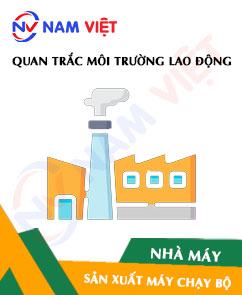
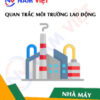
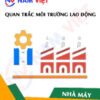
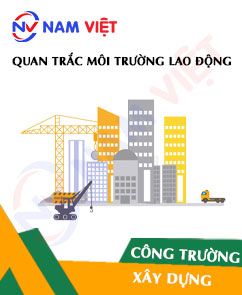
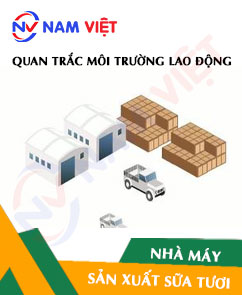
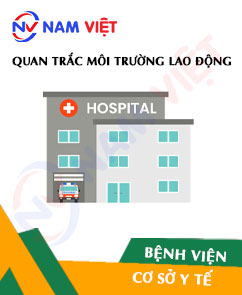





Review Occupational Environment Monitoring at the Treadmill Manufacturing Factory
There are no reviews yet.